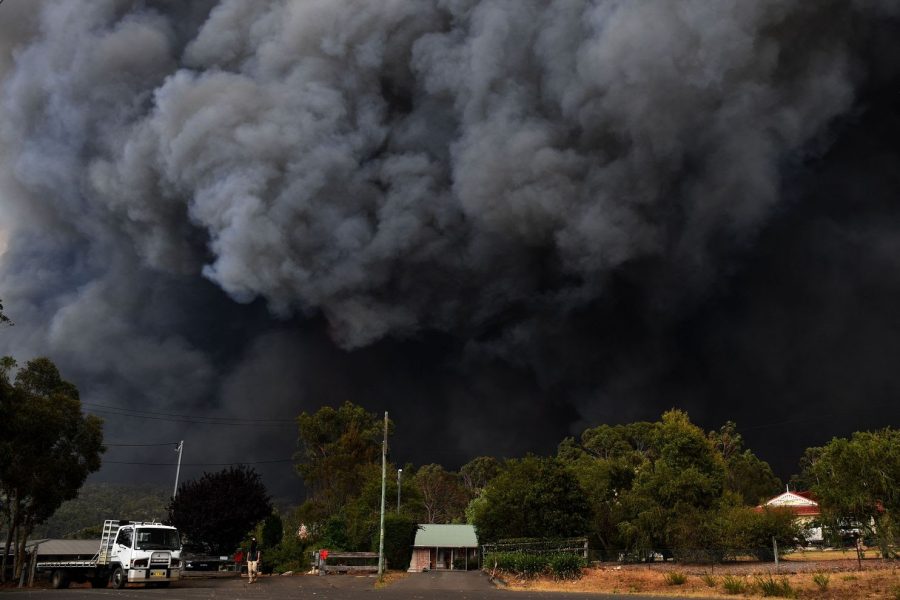Australia is Burning
Photo Credit: (Dean Lewins)
As the fires continue to burn, smoke fills the sky near Sydney, Australia.
January 22, 2020
Australia has been under catastrophic conditions as the bush fires continue to burn. There were about 136 fires burning across Australia which have had disastrous effects on the people and wildlife inhabiting the area.
Across the entire country, at least twenty-four people have died. In the New South Wales area, approximately 2,000 homes have been destroyed. New South Wales seems to be the most affected area.
Some believe that the fires are a product of climate change along with arson. Many people blame Prime Minister Scott Morrison for the fires due to his inaction in regard to climate change.
When it had become evident that Australia had exported more coal than any other country, Prime Minister seemed to mock his parliament by bringing in a piece of coal and saying, “This is coal, don’t be afraid! Don’t be scared!” This goes to show how Prime Minister Morrison does not take this issue as seriously as he should, according to the New York Post.
On January 9th, Scott Morrison visited and spoke with many of the victims of these fires. The event had to end early due to the amount of criticism Prime Minister Morrison received from these people.
Aside from this event, there is also a large group of activists who plan to march across nine cities in Australia. The march was designed to protest the government’s negligence related to climate change.
Many people argue that now is not the time for a political statement, rather everyone’s effort should be focused on helping the victims and putting a stop to the destructive fires.
When asked about the protests, Prime Minister Morrison responded that while he does believe in climate change and does agree with many of the points the protesters stand for, he insinuates putting in place climate friendly changes will do more harm than good for the country.
This includes damaging the economy and not seeing much of an improvement with natural disasters in general, such as the New South Wales bush fires.
Kate Marvel, a NASA climate scientist, said to the New York Post that if nothing is done about the current climate, that Australia will only get hotter and drier causing the frequency and intensity of these fires will surge. Although climate change plays a large factor to the fires, twenty four people have been charged with intentionally starting these fires that became extremely dangerous.
The police have accused or taken legal action against 183 people, forty of which were under the age of eighteen. These people were accused or charged with a variety of fire-related offences, whether it be discarding a lit cigarette or ignoring the total fire ban – a ban that was in place to avoid even more fire related catastrophes.
Humans have not been the only ones affected by these fires. Over 1 billion animals were reported to have perished. A main concern seems to be the amount of koala deaths that have occurred.
Australia is home to multiple endangered species, one of which is the koala. These fires have caused extensive damage to their population, pushing their species even further toward extinction.
The original estimate of animal deaths was somewhere around 480 million animals, but this excludes animals that are difficult to collect data for such as insects, bats, and frogs.
If the habitat loss and actual fires haven’t killed the animals it will be the loss of food.
Until the fires are over, it’s impossible to know the full effects that this tragedy has had on the ecosystems and animals that inhabit the area.
Australia is suffering. Even after these fires are over, the damage will be immense and will cost a lot to repair. Not to mention the effects that could potentially be extremely difficult to restore or even irreversible such as the damage to important ecosystems.
There are many places to donate to and support the victims of the fires, including resources on USA Today.
Human-caused climate change is part of the problems with these fires, so by minimizing carbon emissions, it can help prevent future natural disasters like these.
Some places to donate to help are the fire departments located in New South Wales – visit some of the fire department’s websites for more information on how to donate.
Australian Red Cross is also an available option for donations. Options to donate to specifically to help the wildlife that have been affected by these fires include Australia Zoo Wildlife Hospital.
Over all, the situation in Australia is a dire one, one that needs urgent attention and as much help as it can get.



